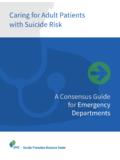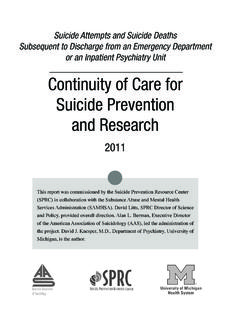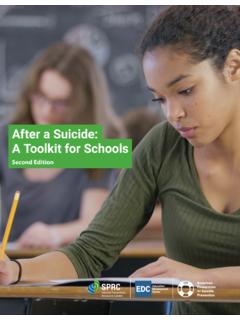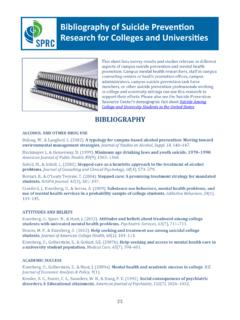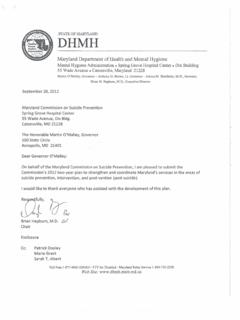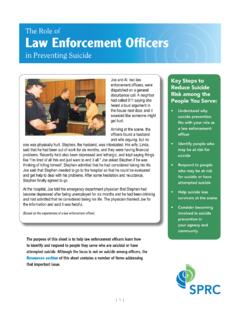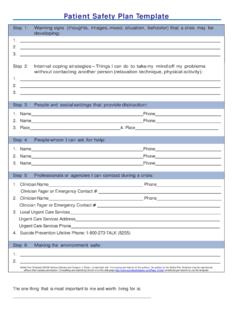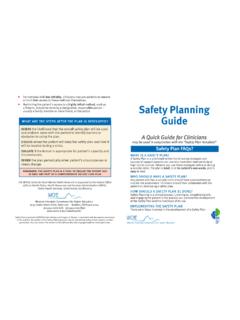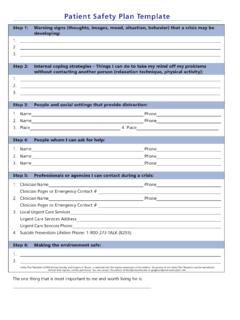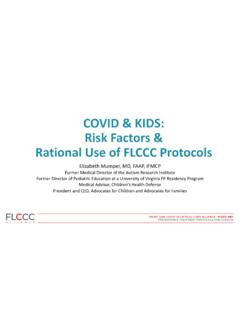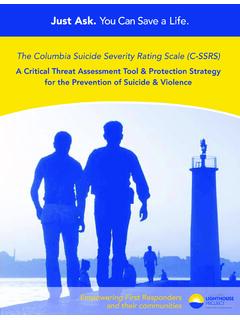Transcription of Goals and Objectives - SPRC
1 1 Kentucky Department for Behavioral Health, Developmental and Intellectual Disabilities 2013 - 2018 STRATEGY FOR suicide PREVENTION Goals and Objectives Strategic Direction 1: Healthy and Empowered Individuals, Families, and Communities GOAL 1. Integrate and coordinate suicide prevention activities across multiple sectors and settings. Integrate suicide prevention into the values, culture, leadership and work of BHDID, to include: o Departmental Goals , all contracts and grants, regulations, plan and budget questions, expanded suicide prevention on state web pages. o Require department approved training for all BHDID professionals, contracted entities (such as peer support and KPFC) and volunteers. o Develop and implement suicide prevention training and T4T modules for peer support to be implemented in BHDID contracted entities. o Develop and implement suicide prevention training and T4T modules for consumer-operated programs to be implemented in BHDID contracted entities.
2 Integrate suicide prevention into the values, culture, leadership and work of organizations and programs with a role to support suicide prevention activities to include: o Systems of care, The State Interagency Council for Services to Children with Emotional Disabilities (SIAC) and social services (foster programs, job assistance, domestic violence prevention, rape crisis centers, DJJ, AOC, Department of Education, community action organizations, etc.) Establish effective, sustainable, and collaborative suicide prevention programming at the state, regional, and local levels. Develop and sustain public-private partnerships to advance suicide prevention, including schools, workplaces and faith-based communities. Integrate suicide prevention into ALL relevant health care reform efforts. Align as appropriate with President s Now is the Time plan for mental health training, services and funding to: o Provide Mental Health First Aid training for teachers; o Make sure students with signs of mental illness get referred to treatment; o Support individuals ages 16 to 25 at high risk for mental illness; o Help schools address pervasive violence; o Train more than 5,000 additional mental health professionals to serve students and young adults.
3 GOAL 2. Implement research-informed communication efforts designed to prevent suicide by changing knowledge, attitudes, and behaviors. 2 Develop, implement, and evaluate communications efforts designed to reach defined segments of the population. Promote outreach to policymakers with dedicated communication efforts including education regarding high costs of emergency department and ambulance calls related to suicidal behavior. Increase communication efforts via all social media that promote positive messages and support safe intervention strategies. Increase knowledge of warning signs for suicide and of how to connect individuals in crisis with assistance and care. o This could include continued promotion of QPR gatekeeper trainings, mandated secondary school-based staff and student suicide prevention trainings, post-secondary staff and students, military/veterans and their families, and Mental Health First Aid training which includes two hours of suicide prevention training.
4 Take advantage of conference opportunities. GOAL 3. Increase knowledge of the factors that offer protection from suicidal behaviors and that promote wellness and recovery. Promote effective programs and practices that increase protection from suicide risk, including resiliency training. Reduce the prejudice and discrimination associated with suicidal behaviors and mental and substance use disorders. Promote the understanding that recovery from mental and substance use disorders is possible for all. This includes promotion of recovery-oriented support systems. GOAL 4. Promote responsible media reporting of suicide . Distribute media guidelines to press associations through training and information sheets. Shape messages to take into consideration their need for ratings. Utilize AP style book release to educate about mental health.
5 Include and educate CHFS communications regarding responsible media reporting. Utilize post-secondary education to educate journalism majors about responsible reporting. Promote positive stories around success stories in suicide prevention ( Kevin Hines and the Golden Gate Bridge). Strategic Direction 2: Clinical and Community Preventive Services GOAL 5. Develop, implement, and monitor effective programs that promote wellness and prevent suicide and related behaviors. Strengthen the coordination, implementation, and evaluation of comprehensive state, regional, and local suicide prevention programming. Encourage community-based settings to implement effective programs and provide education that promote wellness and prevent suicide and related behaviors. Possible settings include: 3 o Clinical service providers including primary care, hospitals, urgent care and emergency departments, emergency service providers, substance abuse prevention services, public health, and other health care providers.
6 O Schools and other youth-serving organizations, post-secondary institutions, workplaces, faith-based organizations, justice and law enforcement, organizations providing health care, military and veteran service organizations, community prevention coalitions and other community partners. Educate and equip Regional Prevention Center staff to integrate suicide prevention into the Strategic Prevention Framework. Pursue funding opportunities for creation of suicide prevention enhancement site. Create and distribute suicide prevention toolkit for grassroots community partners. Intervene to reduce suicidal thoughts and behaviors in populations with suicide risk, to include persons with serious mental illness (SMI) or severe emotional disabilities (SED), males who are middle-aged, persons in military and veterans, youth and young adults, persons who are lesbian, gay, transgender, bisexual or questioning (LGBTQ), as well as others identified at higher risk.
7 Strengthen efforts to increase access to and delivery of effective programs and services for mental and substance use disorders from any entry point. GOAL 6. Promote efforts to reduce access to lethal means of suicide among individuals with identified suicide risk. Integrate lethal means reduction education into all trainings to community and clinical service providers, including conference opportunities such as Kentucky School, Operation Headed Home and Operation Immersion. Encourage providers who interact with individuals at risk for suicide to routinely assess for access to lethal means. Integrate into BHDID monitoring protocol questions about access to lethal means ( Substance Abuse Services, Impact Plus, Prevention). Disseminate emergency department posters and material from suicide Prevention Resource Center. Partner with firearm dealers, Kentucky chapters of National Rifle Association, hunter safety classes, and gun owners to incorporate suicide awareness as a basic tenet of firearm safety and responsible firearm ownership.
8 GOAL 7. Provide training to community and clinical service providers on the prevention of suicide and related behaviors. Provide training on suicide prevention to community groups that have a role in the prevention of suicide and related behaviors. Provide training to mental health and substance abuse providers on the recognition, assessment, and management of at-risk behavior, and the delivery of effective clinical care for people with suicide risk per state statutes and regulations, to include persons with SMI or SED, 4 males who are middle-aged, persons in military or veterans and their families, and persons who are LGBTQ, as well as others identified at higher risk. Integrate into BHDID monitoring protocol to look for state-mandated suicide prevention training in clinical service provider personnel record. Promote the adoption of core education and training guidelines developed at national level on the prevention of suicide and related behaviors by all health professions, including graduate and continuing education.
9 Utilize internal BHDID resources to connect with policy makers. Promote the adoption of core education and training guidelines on the prevention of suicide and related behaviors by credentialing and accreditation bodies. Utilize internal BHDID resources to connect with policy makers. Implement protocols and programs developed at national level for clinicians and clinical supervisors, first responders, crisis staff, and others on how to implement effective strategies for communicating and collaboratively managing suicide risk. Strategic Direction 3: Treatment and Support Services GOAL 8. Promote suicide prevention as a core component of health care services. Promote the adoption of zero suicides as an aspirational goal by health care and community support systems that provide services and support to defined patient populations. Promote inclusion of suicide risk screening and assessment questions in electronic health records.
10 Develop and implement protocols for delivering services for individuals with suicide risk in the most collaborative, responsive, and least restrictive settings. Promote timely access to assessment, intervention, and effective care for individuals with a heightened risk for suicide . Promote continuity of care and the safety and well-being of all patients treated for suicide risk in emergency departments or hospital inpatient units. Encourage health care delivery systems to incorporate suicide prevention and appropriate responses to suicide attempts as indicators of continuous quality improvement efforts. Establish linkages between providers of mental health and substance abuse services and community-based programs, including peer support programs. Coordinate services among suicide prevention and intervention programs, health care systems, and accredited local crisis centers.
